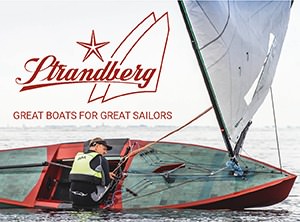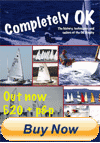You are here: okdia.org > technical > technical manual > windward workout
Technical Manual
Windward Workout
by Trevor Gore
The final race of the 1980 Nationals was something of a catastrophe for me.
Having been unable to spot the windward mark before the start, I hammered up the starboard side of the course expecting to sight the mark in a similar relative position to that of the previous races. A mark was sighted after a very short period of time, but taking it for the wing mark, I hung on on port for another five minutes, scanning the horizon for a mark which was not there.
So, broad reaching in from the windward mark on starboard, I had plenty of time to count the three or so boats behind me and to contemplate on how to stage a recovery.
It was while staging the aforementioned recovery, that I learned not a little; of no benefit to me, however, but some of you guys really ought to pin your ears back and exercise the void between them.
Very few helms were sailing their boats anywhere near to the limit of their craft's capability, including some old hands who by now should know better. I was not trying particularly hard because this race was bound to be my discard, but I was passing between 15 and 20 boats up each beat.
It was interesting to see that most had mastered the finer points of windward work, like shutting their eyes when a big wave broke over them and keeping one bailer down so as not to sink, but all seemed to demonstrate a complete ignorance of why a boat sails to windward at all. If they understood, I would not have been passing them.
Given a boat that will remain in less than two pieces during a complete race and a helmsman sound in wind and mind, it is the foils and their relative positions that uniquely determine the efficiency with which the boat will travel to windward.
For simplicity we will eliminate one of the three, namely the rudder, because (to the extent of this argument) all you do with this is aim the outfit in the correct. general direction. All we are left with is the sail and the centreboard and it is fundamental that both the practical and theoretical aspects of their action and interaction be understood for a boat to be sailed efficiently.
Consider, if you will, fig. 1, a boat sailing to windward with the indicated loading regime acting upon it. The numbers used are not entirely hypothetical, neither are they an in depth analysis of an O.K., but the answers derived are at least in the right ball park.
For static equilibrium in the plane of fig. 1 :
Fs = Fb (=F)
Taking the moments about the C.L.R.; :
800 x 1 = F x 2.87
Giving F = 280 N (approx.) [10N = 2 1/4lb. force]
Lift to be generated by the c/b = 280 Newtons.
If we know how heavy the helmsman is, which we do, we can calculate all the forces acting.
Fs must equal Fb for horizontal equilibrium (otherwise the boat would accelerate off sideways somewhere) and vertical equilibrium is maintained because Archimedes said so.
As you can see, the centreboard has to generate a lift force of 280N. This can only be done by the c/b acting as a foil at some angle of attack, with water flowing over it. It acts just like the sail, but with water instead of air as the working fluid.
The force generated is governed by the simple expression below which is worth considering in some detail.
EQUATION 1: F = Pi p u² a c L
This is aerofoil theory for flow over a flat plate.
L = the foil length, say 0.78m, average
F = lift force in Newtons
p = density of water (= 10³ kg/m³
u = velocity (initially 2m/sec.)
c = average centreboard width (0.40m)
a = angle of attack in radians (x 180/Pi degrees)
Pi = 3.142
As L, Pi ,p and c are all fixed, the only variable we have to play with are U and a. Let's assume a mediocre helm is beating in a force 4, which is too much on a beat for most mid fleet men, and that he can achieve a speed through the water of 2 metres per second. (If you want that in knots, you can work it out!)
Using F as derived above, we can fill in the numbers and find a, which works out to a shade of 4° (4.12°). In reality this figure is somewhat low due to losses and it is the difference between the angle made good to windward and the angle you have the centreline of the boat directed along.
OK, so this is not getting you to the windward mark any sooner, so far. But now you know the rules of the game. All you have to do is apply them to best advantage.
On the evidence of the last Nationals race, the popular thinking is point the boat higher, feather and sail less distance. I'm sat out fully and can't use any more power anyway. You may have been taught to sail like this, but if you are racing it is ALL WRONG. Some of you may spend a bit more time coming to an answer, thinking: Ah! If I can increase a, using a gybing centreboard, I can maintain speed but not sag to leeward, thus sailing less far and getting there sooner.
Good thinking! Pity it is wrong. Gybing boards are totally useless on an O.K.
It we analyse the latter statement first, we shall also cast light on the erroneous thinking of the former, but it requires a deviation into centre boredom first.
For those of you not in the know, centreboards is where it is all at, and has been receiving a lot of development attention recently. I mean, if you ain't got yer super stiff, fully profiled, epoxy glass sheathed, filled in centreboard, who are you man? If you can make it gybe as well, that is something else as well. If you have just bought one, more fool you!
For a given set of conditions, a gybing board will not alter the angle of attack relative to the water. To generate the lift force of equation 1, the angle of attack MUST remain the same, whether the board has been gybed or not. What alters is the angle at which the rest of the boat passes through the water, but you do not travel any higher. The only gain is that the water flows in a direction more along the boat and less across it. Is this worth while?
If you care to work it out, you will find that to gybe a 20mm board one degree, you need to double the minimum width of the slot. If you do this, the slot holds 2kg. more water which travels with you everywhere. That is am extra 2kg. to accelerate after every wave you hit. As most helms screw their boats through waves anyway, the one degree will go totally unnoticed. So it is pretty pointless having a gybing board isn't it?
Stiff board, or flexi board?
For the mid fleet man in a force 4, the stiff board will be the best bet, but only because he will be able to jump on it longer and harder when he has capsized. So what of the flexi board? Here we need to call some more theory to our aid.
A little known, but very useful, fact is that most foils that a sailor will be concerned with, have a centre of lift located ~ of the cord back from the leading edge. So if you build a board which has its point of maximum camber fairly well back and perhaps tilt it more vertically than the designer intended, you cam be pretty sure that it will twist to produce the same effect as a gybing board, but without the weight penalty. And the tip will twist considerably more than a degree. So you need not bother going to the expense of buying a stiff board.
Trim tabs really do pay off, but they disobey the above rules, so I will leave you to your own devices to discover why.
Summarising this section before returning to the original discussion (refer back if you have forgotten what it was!), we have discovered that the boat chooses the angle of attack for a given speed and the helmsman can do little about it.
The only variable we have to play with them is u, which has that magic little 2 by it meaning that any change in u will bring about a large change in F for a given a, or a for a given F; and herein lies the answer.
Let us assume constant F because our helmsman stays fully sat out.
If he feathers and points higher, he loses out in every possible way. He goes slower, makes more leeway and puts the boat right out of balance. The first two losses are directly related by equation 1. If we put some numbers in, we will get a graphic illustration showing why.
Imagine his speed loss by pointing higher is 25%, taking his velocity through the water from 2m/sec. down to 11/2m/sec. For constant F, what is the value of a? Answer = 7.33°.
Now suppose instead, he keeps power on, bears away a little and goes 25% faster. Velocity now 21/2m/sec. For constant F (280N) a = 2.67°.
In the real situation, the losses of the slower boat will be compounded because it will be more susceptible to being stopped and generally knocked about by waves, so the difference between the two results diverges even further. The situation theoretically arises where the slow boat sagging to leeward and the fast boat sailing free, end up making good to windward on parallel courses, the only (!) difference being the 60% speed difference! The careful observer night have seen this order of gain being realised in the practice race of the Nationals.
Almost home! We have now defined the problem and formulated the solution. All we have to do is execute it!
It should be obvious to you all now that I an advocating 'power sailing'. It is also obvious that you are not all 6'3' tall, 131/2 stone without weight jacket. National champions, but clearly in these circumstances, more righting moment is advantageous, so heavies score well. But now we come to the crunch.
The trick is to get more forward driving component for a given lateral component (F). Easy. Bear away and ease sheets.
Now the hard bit. (It had to come!) How much does one have to bear away and how do you lose the excess power you still have! Answer, depower the rig. This DOES NOT mean letting the LUFF of the sail lift. This is precisely what not to do. You will just end up feathering again. Pull all the control lines hard and if you have a decent rig (which at least 30% of you do) the sail should flatten until eventually the whole leech inverts and the last two feet of the sail width down the whole leech length contribute nothing towards drive or healing moment. If you have chosen the rig for your weight, it should be possible to break the leech off controllably from the head down, leaving enough power there so you can just keep the luff permanently filled and you should point as high as possible without letting the luff lift. This usually means sailing freer as the wind gets stronger.
The limit to which this technique can be utilised depends on the skill with which it is used and the conditions prevailing. But it is still beneficial with the boom around 600mm outside the quarter as long as the sail can still be adequately controlled. At this sort of boom position. you will have easily run out of traveller. Could this be why some well known exponents have such massive and efficient kicking straps.
Keeping the power in the luff has numerous advantages. The sail is far better supported as an aerofoil and maintains a fairly constant angle of attack down its length. The camber in the part of the sail being used, is far more efficient and constant than you would ever find in a twisted off leech. And remember the 1/4 cord rule. The centre of effort stays well.. forward and the boat will be well balanced. The helm loading therefore remains small and so there is little braking effect. If you let the luff lift, the centre of effort moves back a good 6Oomm and there is no way you can accommodate that by swinging the centreboard. Of course, I am assuming that the boat is always kept upright.
So now you know. Sail faster and get there sooner. Obvious isn't it! Or, you take the high road and I'll take the low road, and I'll get to the windward mark afore ye.
Illustrations
Note
Trevor Gore at his most theoretical.










